
General Linguistics Semantics:Sense Relations 楚军 外国语学院
Semantics: Sense Relations 楚军 外国语学院 General Linguistics
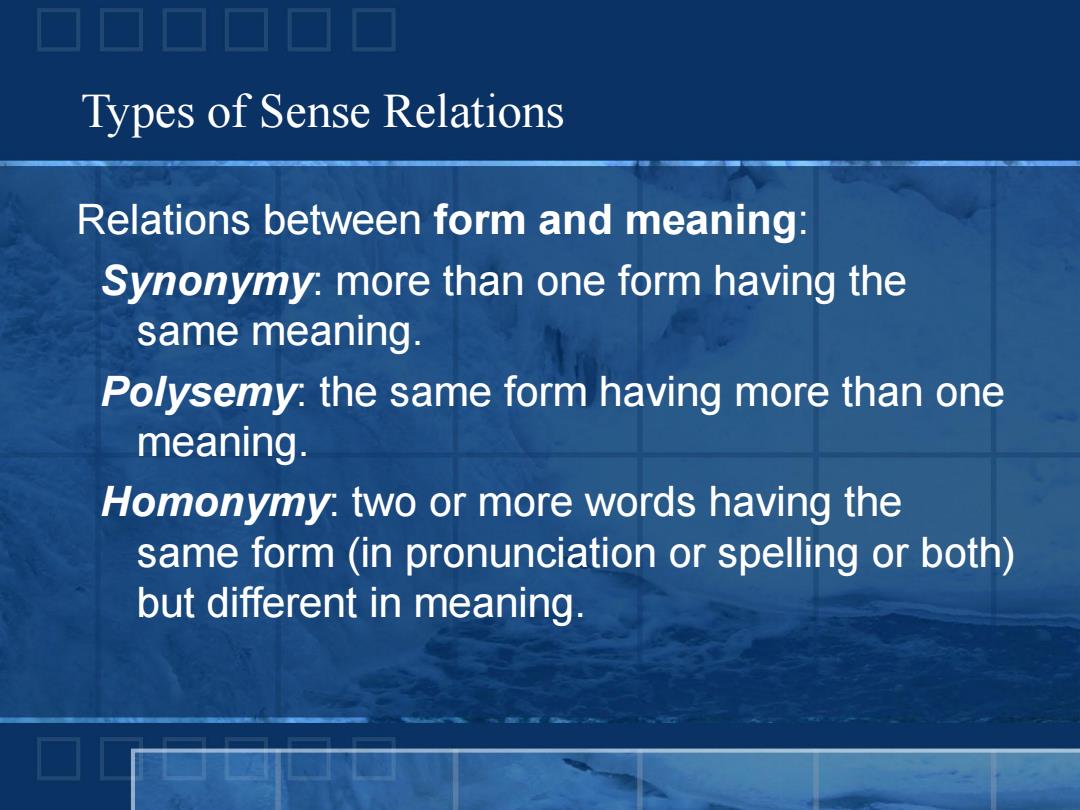
Types of Sense Relations Relations between form and meaning: Synonymy:more than one form having the same meaning. Polysemy:the same form having more than one meaning. Homonymy:two or more words having the same form (in pronunciation or spelling or both) but different in meaning
Types of Sense Relations Relations between form and meaning: Synonymy: more than one form having the same meaning. Polysemy: the same form having more than one meaning. Homonymy: two or more words having the same form (in pronunciation or spelling or both) but different in meaning
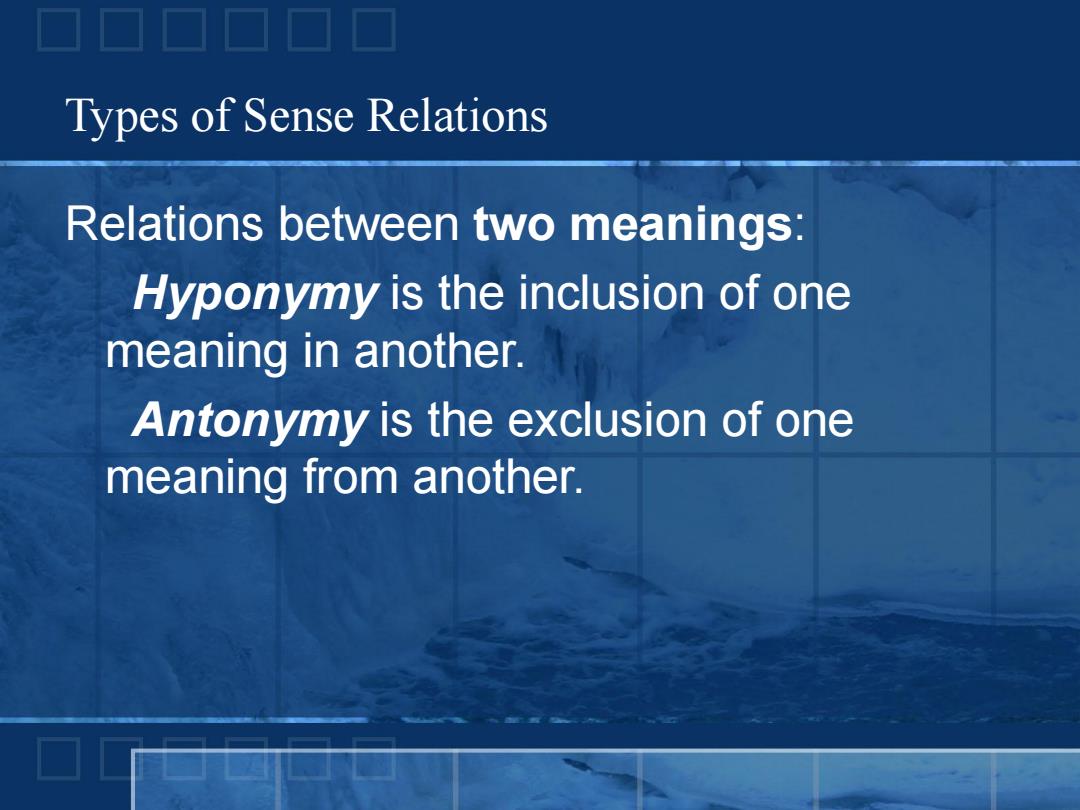
Types of Sense Relations Relations between two meanings: Hyponymy is the inclusion of one meaning in another. Antonymy is the exclusion of one meaning from another
Types of Sense Relations Relations between two meanings: Hyponymy is the inclusion of one meaning in another. Antonymy is the exclusion of one meaning from another
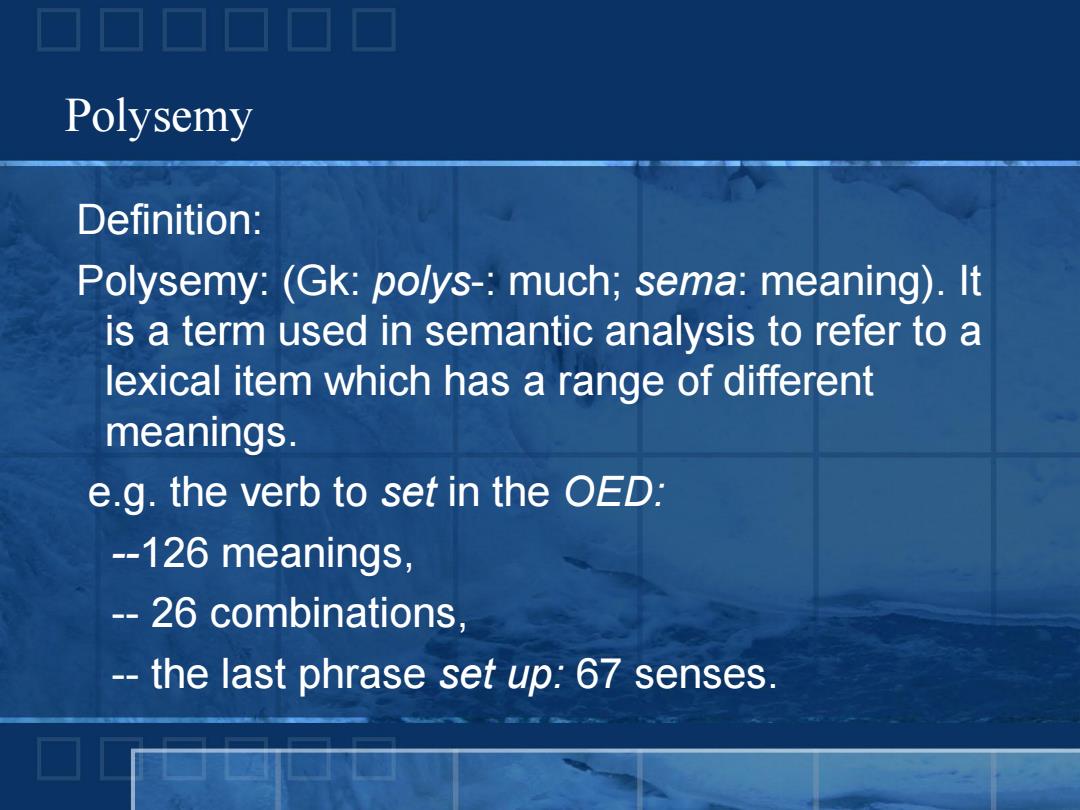
Polysemy Definition: Polysemy:(Gk:polys-:much;sema:meaning).It is a term used in semantic analysis to refer to a lexical item which has a range of different meanings. e.g.the verb to set in the OED. --126 meanings, --26 combinations, -the last phrase set up:67 senses
Definition: Polysemy: (Gk: polys-: much; sema: meaning). It is a term used in semantic analysis to refer to a lexical item which has a range of different meanings. e.g. the verb to set in the OED: --126 meanings, -- 26 combinations, -- the last phrase set up: 67 senses. Polysemy

Polysemy How can language do in order to reflect or express the new ideas,new process,new products? To coin a new word; To borrow a word from other languages; To add new meanings to established words. The simplest and best way is to have old words take on additional new meanings
• How can language do in order to reflect or express the new ideas, new process, new products? • To coin a new word; • To borrow a word from other languages; • To add new meanings to established words. The simplest and best way is to have old words take on additional new meanings. Polysemy
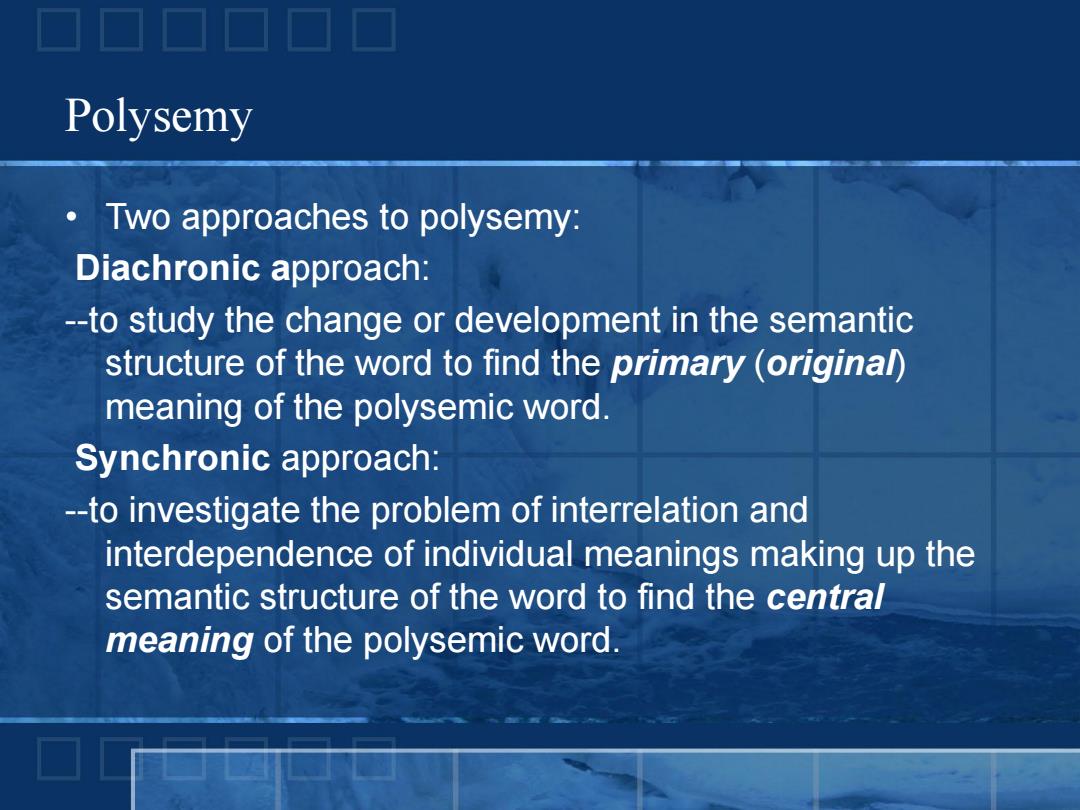
Polysemy Two approaches to polysemy: Diachronic approach: --to study the change or development in the semantic structure of the word to find the primary (original) meaning of the polysemic word. Synchronic approach: --to investigate the problem of interrelation and interdependence of individual meanings making up the semantic structure of the word to find the central meaning of the polysemic word
• Two approaches to polysemy: Diachronic approach: --to study the change or development in the semantic structure of the word to find the primary (original) meaning of the polysemic word. Synchronic approach: --to investigate the problem of interrelation and interdependence of individual meanings making up the semantic structure of the word to find the central meaning of the polysemic word. Polysemy
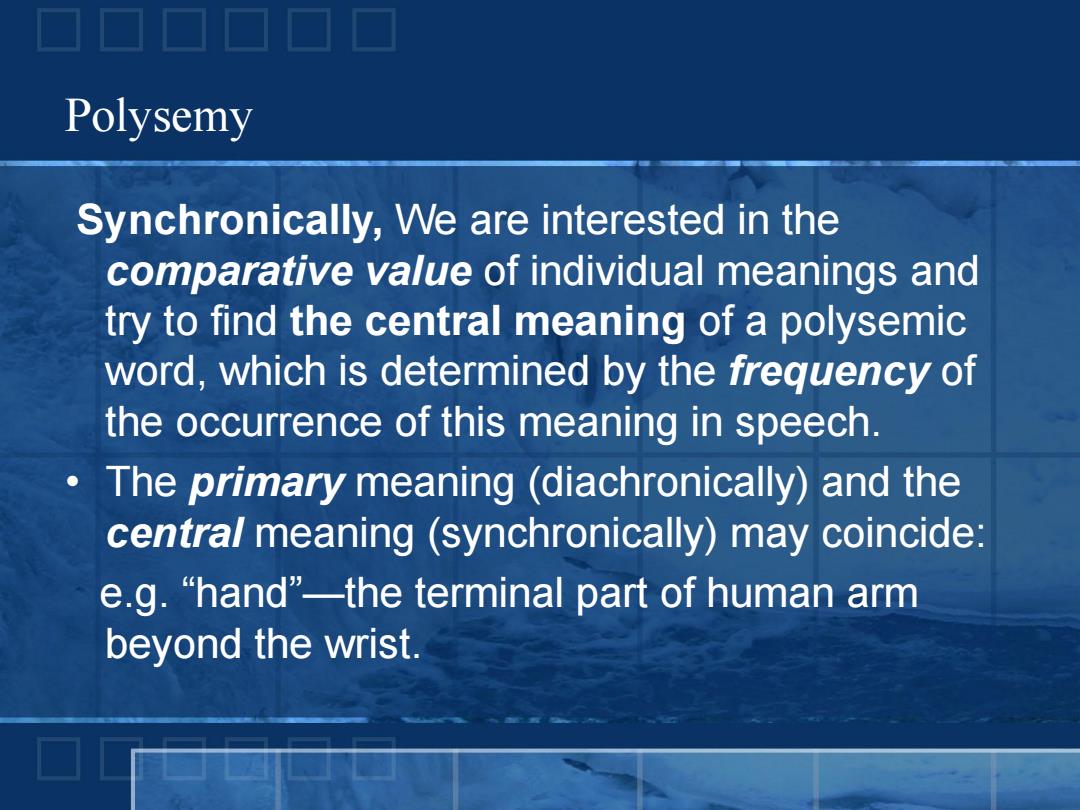
Polysemy Synchronically,We are interested in the comparative value of individual meanings and try to find the central meaning of a polysemic word,which is determined by the frequency of the occurrence of this meaning in speech. The primary meaning (diachronically)and the centra/meaning (synchronically)may coincide: e.g.“hand”-the terminal part of human arm beyond the wrist
Synchronically, We are interested in the comparative value of individual meanings and try to find the central meaning of a polysemic word, which is determined by the frequency of the occurrence of this meaning in speech. • The primary meaning (diachronically) and the central meaning (synchronically) may coincide: e.g. “hand”—the terminal part of human arm beyond the wrist. Polysemy

Polysemy The primary and the central meanings may not coincide: “table”has the following meanings: (1)a piece of furniture; (2)the persons seated at a table; (3)the food put on a table,meals; (4)a flat slab of stone or wood (O.E.tabule); (5)words put into or on it; (6)an orderly arrangement of facts,figures; (7)part of a machine tool; (8)a level area,a plateau
Polysemy The primary and the central meanings may not coincide: “table” has the following meanings: (1) a piece of furniture; (2) the persons seated at a table; (3) the food put on a table, meals; (4) a flat slab of stone or wood (O.E. tabule); (5) words put into or on it; (6) an orderly arrangement of facts, figures; (7) part of a machine tool; (8) a level area, a plateau
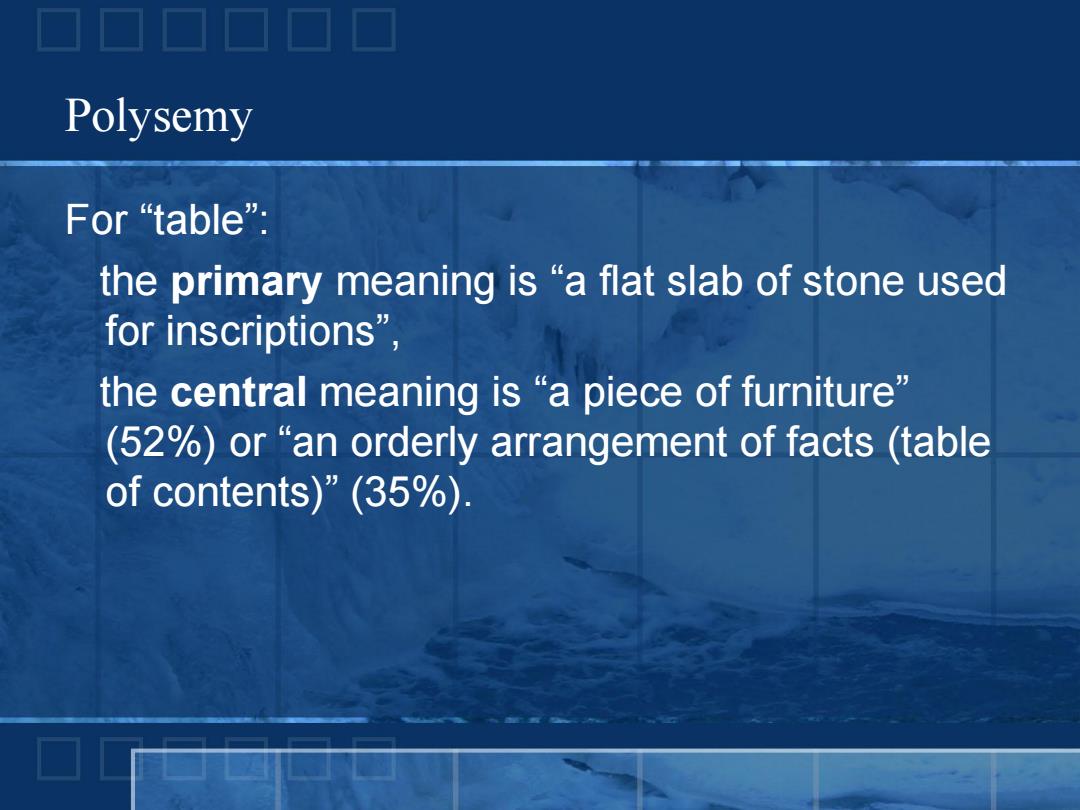
Polysemy For“table”: the primary meaning is "a flat slab of stone used for inscriptions”, the central meaning is "a piece of furniture" (52%)or "an orderly arrangement of facts (table of contents)”(35%)
For “table”: the primary meaning is “a flat slab of stone used for inscriptions” , the central meaning is “a piece of furniture” (52%) or “an orderly arrangement of facts (table of contents)” (35%). Polysemy

Polysemy Two processes leading to polysemy: Radiation(词义辐射)&Concatenation(词义连锁) Radiation: a semantic process in which the primary or centra/meaning stands at the center while secondary meanings radiate from it in every direction like rays.(see the example in the textbook)
Polysemy • Two processes leading to polysemy: Radiation (词义辐射) & Concatenation (词义连锁) Radiation: a semantic process in which the primary or central meaning stands at the center while secondary meanings radiate from it in every direction like rays. (see the example in the textbook)